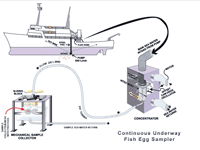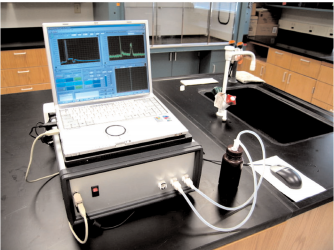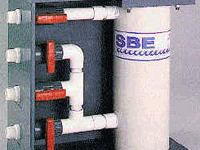 |
The Continuous Underway Fish Egg Sampler (CUFES) is an instrument used to collect pelagic eggs of fish and related hydrographic data from ~3m depth on a moving ship. These samples and data, typically collected during winter and spring cruises, are used to investigate spawning habitat and estimate spawning biomass. When large aggregations of fish eggs are present, Pair-o-vet vertical net tows are done to calibrate egg density.
The CUFES system consists of a inboard or outboard submersible pump, concentrator and sample collector. Water is pumped continuously from a fixed depth (surface to 3 m) to the concentrator on board ship. Eggs and similarly-sized particles are retained in the sample collector. CUFES operates continuously under most sea conditions.
 |
ADCP continuous profiles of ocean currents and acoustic backscatter between 20 and 500 meters deep are measured along the shiptrack from a hull-mounted 150 kHz Acoustic Doppler Current Profiler (ADCP). The ADCP data are averaged over 3-minute intervals; typically sixty 8-meter depth bins are recorded. On NOAA vessels, ADCP data collection may be altered by the multi-frequncy fishery acoustics sampling scheme.
 |
A combination of multi-frequency acoustics and midwater trawl samples are used to estimate the biomass and distribution of mesopelagic and epipelagic (sardine and anchovy) fishes as well as macrozooplankon and identify areas of enhanced productivity and concentration in the southern California Current.
 |
Continuous underway analysis of phytoplankton pigment groups and variable fluorescence (Fv/Fm). ALF, developed by A. Chekalyuk at Lamont-Doherty Earth Observatory, uses laser stimulated emission at 405 and 532 nm together with spectral deconvolution analysis to distinguish fluorescence from three types of phycoerythrin, chlorophyll-a, and chromophoric dissolved organic matter (CDOM). The ALF is useful for differentiating the contribution of cyanobacteria and cryptophytes from other phytoplankton taxa present in natural phytoplankton assemblages, as well as for assessing phytoplankton photophysiological status.
 |
All CalCOFI ships actively collect sea surface, meteorological, and other types of continuous data. There are differences in systems used between boats and agencies as well as differences in data types and availability. The core parameters that are most reliably collected are navigational data such as GPS, thermosalinographic and fluorometeric data, and various types of atmospheric data such as wind and ship speed.
 |
In April 2004, a visual and acoustic marine mammal survey component was added to the CalCOFI project to study cetacean ecology and habitat. Visual monitoring is conducted during quarterly cruises by experienced marine mammal observers using handheld 7x binoculars. Supplementary Bigeyes (25x magnification) or image stabilizer hand-held binoculars (18x magnification) are used for species identification when necessary. Visual monitoring provides excellent data for highly visible species in calm to moderate weather.
Concurrently, an acoustic technician surveys with a towed hydrophone array during the transit between CalCOFI stations and with sonobuoys while on station, allowing collection of distribution data on vocal animals that may have been missed visually due to darkness, rough weather, distance from transect line, being underwater, or other reasons.
These data provide information on the annual and seasonal presence of cetaceans, and may be used to evaluate daily patterns of vocalization behavior. By integrating CalCOFI environmental and cetacean data, we plan to develop ecological models for cetacean habitat in the region offshore of southern California and to improve our understanding of their role in the California Current ecosystem.
Current interest in ocean acidification has led to development and deployment of an underway pCO2-pH system. Built in the lab of Dr. Todd Martz at Scripps Oceanography for LTER, the system is installed by CALCOFI on our quarterly cruises. The system is comprised of a Sunburst Sensors SuperCO2 system for pCO2, a Durafet III pH electrode analyzer used to measure pH (via Honeywell UDA2182), and a Seabird SBE45 thermosalinograph. Output data from these systems is merged in real time with Lat/Long position on a data hub consisting of a PC running LabView software. Using the ship's uncontaminated seawater feed from ~3m, near-surface data are acquired 7/24 during the cruise.
Links: SCCOOS Ocean Acidification | Dr Todd Martz, SIO | Publications
 |
Since 1987, seabirds and marine mammals have been surveyed along the CalCOFI transect during daylight hours while the ship is underway. Data counts on seabirds and marine mammals are entered into a handheld computer in real time and are available to filter or download on the Datazoo webpage. Bird observers participating on CalCOFI cruises are provided by support from the Farallon Institute for Advanced Ecosystem Research (Jul 2007 to present) and Point Reyes Bird Observatory (PRBO, 1987-2006).
